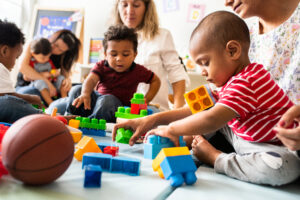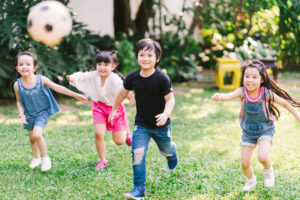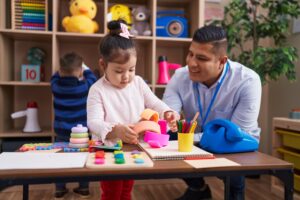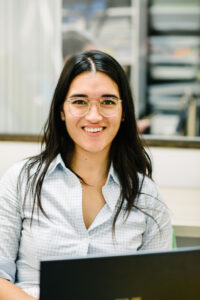Multilingual Communication Development
Any child that regularly hears more than 1 language is considered a multilingual communicator.
In this blog, Speech Pathologist Thida discusses multilingual communication development, answers some common questions, and shares her thoughts about neurodivergent children (e.g. children who are autistic) who are also multilingual communicators.

Think about your child, or the children in your class…
Do they regularly hear a language that is different to what you speak with them?
Do the adults at home speak a different language to the adults at daycare, kindy or school?
Do you have family or friends that often visit or call, that speak a different language?
Does the child hear more than 1 language, even though you only speak to the child in English?
Is the child seeing or learning to use other forms of communication, like sign language or communication devices?
If you answered ‘yes’ to any of these questions, the child you are thinking of is probably a multilingual communicator!
Research shows that a child only needs 10-25% of exposure to a language to start learning the language; even if they don’t speak the language or you are not deliberately teaching them the language (Byers-Heinlein, K., & Lew-Williams, C., 2013).
Just being around these other languages is enough to start learning.
This could be happening at kindergarten, home, shopping centres, parks, other homes, or other places the child regularly visits.
Multilingual communication development looks different to those learning 1 language…
How well a child speaks and understands a language depends on how much they have heard the language, and how much they get to practise using or speaking the language.
The more the child hears and practises using a language, the more they can understand and speak that language (Feldman, 2019).
It doesn’t matter how well the adults (or other children) speak the new language that the child is listening to, because the most important thing for learning and development is how much the child is hearing (Verhagen et al., 2022).
So keep talking to the child in all of your languages!
There are 2 different types of multilingual development…

- Learning all languages from when the child was a baby (Example: both parents speak English and Thai to their baby from birth)
- Hearing the 2nd or 3rd language, after the child starts developing and using a 1st language (Example: both parents speak Malayalam to their baby, and then the child starts hearing English at age 3 when they start an English-speaking daycare )
Children who have been learning all of their languages since birth will often learn and use new words faster.
Children who started learning a new language later will often have more speech mispronunciations, and it is more common for these children to have a ‘silent period’. A silent period is when the child does not talk or only talks a little bit while they are listening to and processing the new language.
Both types of multilingual children will often show errors and difficulties with their grammar and sentence structures. Both types will also usually mix the words, grammar and sentence structures of their different languages to help them explain their messages – this is called ‘code switching’.
Code switching is not a sign that the child is confused, and it is a good thing!
It means that the child is learning and progressing with their language development.
With regular exposure and opportunities to practise speaking all of their languages, multilingual children will develop their language skills to be able to make friends, learn at school and communicate their messages.
If they are having difficulties in one of their languages, it is likely that the child just needs more exposure to that language and more practise. If the child is showing difficulties developing all of their languages, then this is a sign to get help from a Speech Pathologist.
What about children with a diagnosis?

This is a really good question, especially because there is not a lot of concrete research available to guide Speech Pathologists, teachers and families.
There is early research that suggests that Autistic children do have the capacity to develop and maintain more than one language (Howard, et al., 2021).
In my own clinical practice, I have definitely seen this with some of my multilingual families who have an Autistic child. I have worked with clients in the past (and now) who show an understanding of different languages and cultures, as they use words and greetings in different languages for their different family members – such as using English with their sister, but Spanish to talk to their grandmother.
Based on the evidence that is available and my own clinical experiences, I would say that it is up to the child’s family to make the language decision that works best for them. As teachers, educators and therapists, we can make sure that the families and communities we work with have all the information they need to understand multilingual communication development, so that the families can make an informed choice – and then support that choice!
The everyday moments and conversations we have with multilingual children are the key to supporting their development…
Children develop their language best when they are in fun and meaningful conversations with the people in their lives. And multilingual language is no different!
The best thing adults can do to help multilingual children?
Keep talking to them (Feldman, 2019). Play with them, and help them play with other children who are using the language/s they are still developing.
Use a lot of words and sentences in the language/s, without forcing the child to copy or reply.
Keep your sentences simple and repetitive, and give the child many chances to have a go at responding – both with their own words and other ways, such as pointing or showing.
Happy talking!

Thida Hantun
Certified Practising Speech Pathologist
References:
Byers-Heinlein, K., & Lew-Williams, C. (2013). Bilingualism in the Early Years: What the Science Says. LEARNing landscapes, 7(1), 95–112.
Feldman, H. (2019). How young children learn language and speech: Implications of theory and evidence for clinical pediatric practice. Pediatrics in Review, 40(8): 398–411. doi:10.1542/pir.2017-0325.
Verhagen, J., Kuiken, F., & Andringa, S. (2022). Family language patterns in bilingual families and relationships with children’s language outcomes. Applied Psycholinguistics, 43(5):1109-1139. doi:10.1017/S0142716422000297
